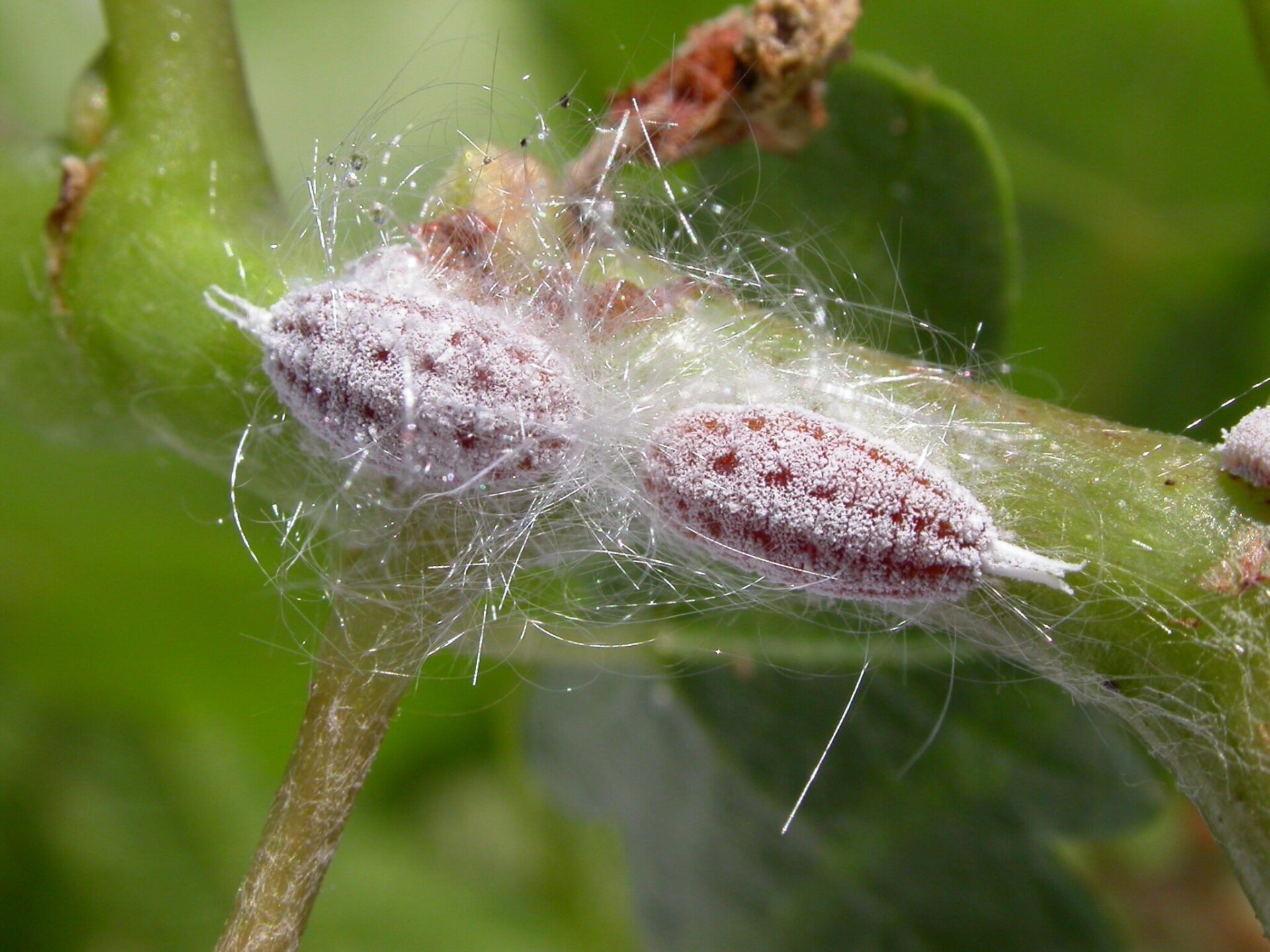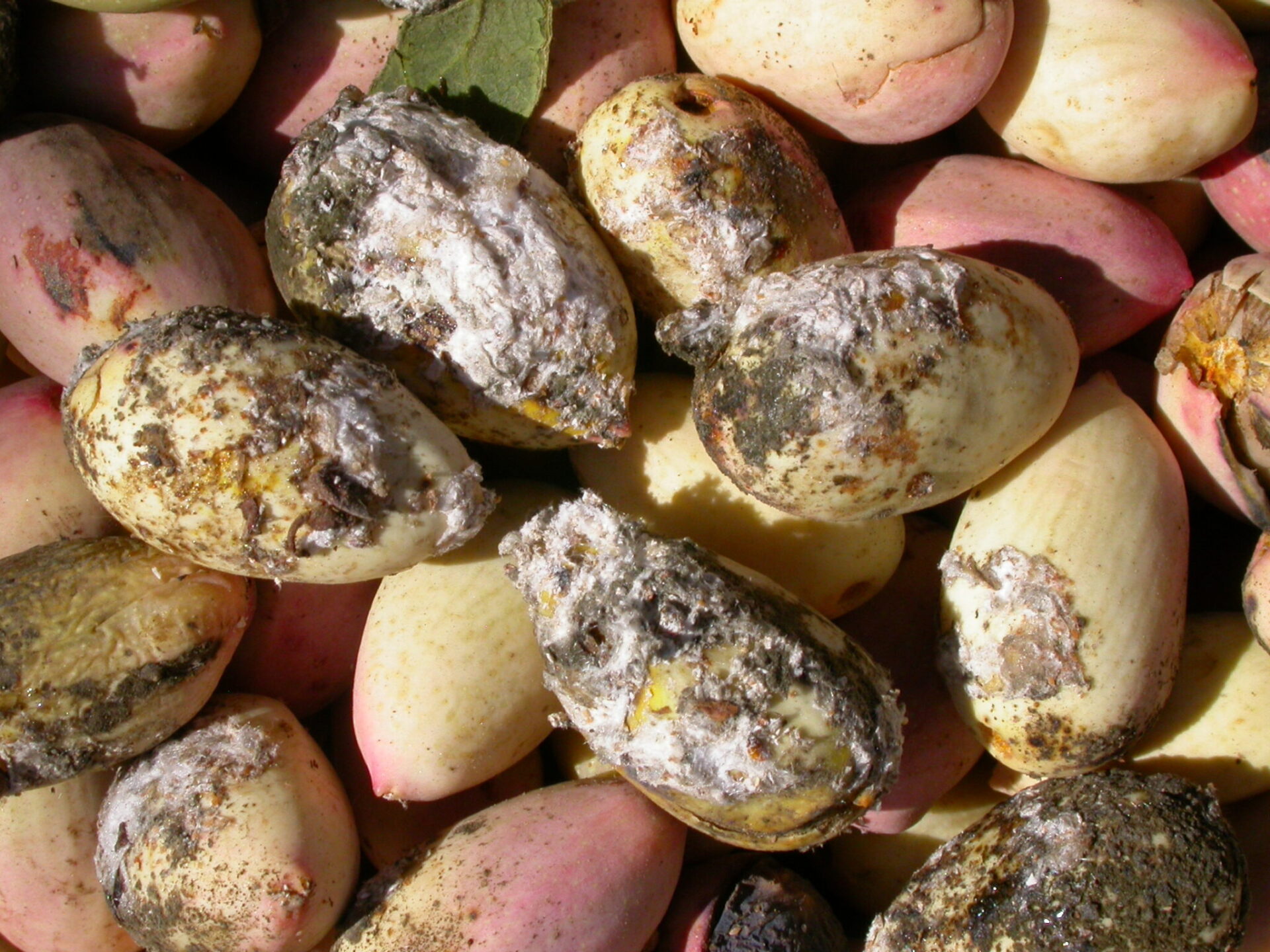
Over the past two decades, Gill’s mealybug has become entrenched within pistachio orchards in California. Each year, new orchards become infested as the distribution of mealybugs in infested orchards becomes ubiquitous. Unfortunately, insecticide programs that used to be highly effective against the Gill’s mealybug are becoming less and less effective, and growers have been exploring new and creative ways to try to achieve control.
In some cases, this has led to the rejection of fruit in export markets due to pesticide residues. Most notable in 2020 were rejections in the European Union for fruit that exceeded the 0.05 ppm tolerance for imidacloprid (Admire Pro and more than 25 other labeled products.) This concern is likely to increase due to plans in the E.U. in 2022 to decrease this imidacloprid tolerance to the default maximum residue limit (MRL) of 0.01 ppm. This means that 2021 crop sold in the E.U. in 2022 will have to meet the new standard. This issue is similar to the one facing buprofezin (Centaur) that also has a default MRL in the E.U. of 0.01 ppm. Default MRLs can be difficult to satisfy because they are based on minimum detection levels of residues instead of the levels at which residues are known to pose no health or environmental concerns.
One-Spray Programs in May
Traditional insecticide programs for Gill’s mealybugs were developed in the early 2000s based on research on mealybug biology that was conducted in commercial pistachio orchards in Tulare County. Data showed that during the last week of May, a very high percentage of Gill’s mealybugs were synchronized in the first instar developmental stage, often referred to as a crawler. These tiny nymphs crawl over plant tissues where they are easily exposed to pesticides. Because they were just born and have not fed, they have minimal carbohydrate reserves and have not developed the thick waxy cuticle that makes larger mealybug nymphs and adults relatively immune from most insecticide applications. Research from 2005 to 2007 showed that one well-timed application of an effective insecticide in the last week of May would easily provide season-long mealybug control.
The most common options for one-spray programs include Movento, Centaur, Assail, Admire and the newcomer Sequoia. Profiles for each of these products, including concerns regarding tolerances for residues in exported fruit, are described below.
Centaur (buprofezin) is an insect growth regulator that affects the ability of mealybugs to produce chitin. Most susceptible are first-instar nymphs (crawlers) that pick up residues as they walk over the surface of plant tissues and become unable to molt. Maximum efficacy from this product is tied to the ability to apply it at the time crawlers and other small nymphs are present. The primary concern with the use of buprofezin relates to the destination of the crop. The E.U. has imposed a default MRL of 0.01 ppm, which has a high risk of being exceeded when foliar applications are made in May. For this reason, growers should consult with their processor regarding whether or not the E.U. is a potential destination of their crop. If the answer is yes, do not apply Centaur in May.
Movento (spirotetramat) is a lipid biosynthesis inhibitor that prevents mealybugs from producing fat bodies that are used to store energy. Most susceptible are small nymphs that have no fat reserves and are unable to produce new ones. Over a few days to weeks, these mealybugs run out of energy and die. One unique property of Movento is that it is systemic in both the phloem and xylem. After an application is made to the leaves, ideally with a good penetrating surfactant to assist its movement into the leaf, the active ingredient moves within the plant to locations where mealybugs are feeding. Because of the time it takes for the active ingredient to penetrate the leaf, become systemic, be ingested, inhibit fat production and eventually cause mealybug death, pest managers are advised to wait two to three weeks after application to evaluate full efficacy. The best application timing for Movento is at the front end of the main crawler emergence in the second or third week of May. This application timing is about a week earlier than the ideal application timing for other products to give time for the active ingredient to penetrate the leaf and become systemic within the phloem liquids that are ingested by the mealybugs.
Assail (acetamiprid) is a foliar-applied neonicotinoid that affects the nervous system of mealybugs. Like other products previously mentioned, it is most effective against the crawler stage that is not protected by the thick waxy cuticle typical of larger nymphs and adults. Applications of this product can be made at the May timing; however, most growers avoid using this product in May to keep it in their insecticide toolbox in case a second insecticide treatment is needed during the second half of July when crawlers of the second generation of mealybugs begin. Assail is widely accepted as the most effective insecticide that can be used in July, and its use does not raise concerns about pre-harvest intervals and tolerances for residues at harvest.
Admire (imidacloprid) is also a neonicotinoid that affects the nervous system of mealybugs. Over the past decade, it has historically been used at the maximum label rate as a soil-applied product. In relation to the products previously mentioned, it is not as effective on mealaybugs, but when considering that the product is relatively inexpensive and can be applied through the drip system without the costs of a foliar application, it becomes a viable option for orchards with low mealybug populations, or as a supplementary treatment to foliar applications of other products made in May.
However, it is extremely important to recognize that recently there were a considerable number of fruit rejections in the E.U. for 2020 crop that exceeded the tolerance when sold in 2021, and that the tolerance will be decreasing for crop sold in 2022. To proactively address this issue, on Feb. 26, the Administrative Committee for Pistachios (ACP) sent out a directive to all growers and processors that fruit shipped to the E.U. should satisfy three requirements:
No foliar applications of imidacloprid should be made in 2021.
If imidacloprid was applied as a soil injection in 2020, then no imidacloprid applications should be made in 2021.
If imidacloprid is applied to the soil in 2021, applications should be made prior to May 15.
Adherence to these guidelines will be crucial in efforts of the industry to ensure the acceptability of fruit in E.U. markets. For growers with advance knowledge that their fruit will not be going to E.U., the ACP did not recognize any concerns regarding residues when imidacloprid is used at the traditional timing in May when the product is most effective.
Sequoia (sulfoxaflor) is a new foliar insecticide within the pistachio industry. It is a nerve toxin that is classified as new mode of action (IRAC 4C) known as sulfoximines. In UC trials, it has shown sufficient efficacy against Gill’s mealybug to begin including it into rotations with other products. This has potential benefits for mealybug control, but also as a new mode of action in the spray rotation to help prevent resistance to all products. Unlike other mealybug products, Sequoia also has activity against small bugs like lygus and can provide some suppression of stink and leaffooted bugs. Maximum residue limits and import tolerances for sulfoxaflor have been established in many export markets; however, as is true with any new product, growers should consult with their processor regarding potential export markets and confirm the latest information on MRLs before using Sequoia. If used, the best application timing would be at peak crawler emergence in May.

Multi-Spray Programs
Over the past few years, pistachio growers throughout the San Joaquin Valley have reported that they are no longer achieving season-long control with one application of traditional insecticide products. Nobody knows the exact cause for the reduced efficacy, but one leading candidate is resistance following more than a decade of use of buprofezin, spirotetramat, imidacloprid and acetamiprid. Another theory is that changes in weather over the past 15 years have caused mealybugs to be less synchronized than in the past. More specifically, some people have theorized that what used to be a rather synchronized start to mealybug activity in March has become more spread out and asynchronous during abnormally warm winters and springs, or due to significant reductions in the amount of winter fog compared to 15 years ago. During 2021, Kent Daane will be conducting research to investigation this theory.
For cases where one spray is not adequate, growers have several options. For the past decade, the most common two-spray program has been Movento or Centaur (assuming the fruit is not going to the E.U.) at the traditional May timing followed by Assail in the second half of July when the next generation of crawlers is present. This program has also historically been supplemented by a soil application of a product containing imidacloprid, though this practice is now in question for fruit with the possibility of being destined to the European Union. Another option is to make a foliar application of an insecticide previously mentioned (not pyrethroids—they are not effective on mealybugs) immediately after harvest in September or early October when crawlers of the overwintering mealybug generation are present, or in March as overwintering mealybugs (still small nymphs) move up to and begin feeding on the swelling buds and new plant tissues.
The March timing is being promoted heavily by the manufacturers of Centaur as a way to maintain use of the product at a timing that avoids the issues of default tolerances in the E.U. that were previously described when the product is used in May. Thus far, my personal opinion regarding these trials (mostly done as observational trials by pistachio growers or by chemical manufacturers) is that neither of these alternate timings are as good as the May timing, but both are viable options to provide supplemental mealybug control when a two-spray program is needed. For the 2021 and 2022 growing seasons, the California Pistachio Research Board has funded research that will further investigate the efficacy of these alternate spray timings.
Ask Questions, Be Prepared
Gill’s mealybug continues to spread and become more entrenched within the California pistachio industry, and is becoming more difficult to control. When developing programs for 2021, the first questions to ask are: 1) How much mealybug pressure do I have in the orchard; 2) Will I likely need a one or two-spray program; and 3) Where is the fruit going? It is highly advised that pistachio growers talk to their processor regarding these issues as each processor is well aware of issues associated with residue tolerances, knows the export markets in which sales are anticipated, and most have developed guidelines for what their growers should (and should not) do regarding insecticide treatments to maximize marketability. In some cases, individual processors have developed guidelines that are more restrictive than the ones presented herein as general guidance for the entire pistachio industry.















